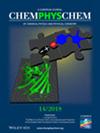封面特色:超导氢化锂在化学电容器设置:理论研究(chemphysichem 13/2025)
IF 2.2
3区 化学
Q3 CHEMISTRY, PHYSICAL
引用次数: 0
摘要
封面特征显示,氢化锂是一种透明的电绝缘体(左图),当在化学电容器装置中进行空穴掺杂时,可能会变成一种很好的类铜金属(右图)。冷却后,将成为超导体,超导临界温度高达17.5 K。更多信息可以在E. R. Margine, W. Grochala及其同事的研究文章中找到(DOI: 10.1002/cphc.202500013)。艺术品由Małgorzata f本文章由计算机程序翻译,如有差异,请以英文原文为准。

Cover Feature: Superconducting Lithium Hydride in a Chemical Capacitor Setup: A Theoretical Study (ChemPhysChem 13/2025)
The Cover Feature shows that lithium hydride, a transparent insulator of electricity (left), may be turned into a good copper-like metal (right) when hole-doped in a chemical capacitor setup. Upon cooling, it will become a superconductor with a superconducting critical temperature of up to 17.5 K. More information can be found in the Research Article by E. R. Margine, W. Grochala and co-workers (DOI: 10.1002/cphc.202500013). Artwork by Małgorzata Fürst based on a photograph by James St. John used under a CC-BY 2.0 licence.
求助全文
通过发布文献求助,成功后即可免费获取论文全文。
去求助
来源期刊

Chemphyschem
化学-物理:原子、分子和化学物理
CiteScore
4.60
自引率
3.40%
发文量
425
审稿时长
1.1 months
期刊介绍:
ChemPhysChem is one of the leading chemistry/physics interdisciplinary journals (ISI Impact Factor 2018: 3.077) for physical chemistry and chemical physics. It is published on behalf of Chemistry Europe, an association of 16 European chemical societies.
ChemPhysChem is an international source for important primary and critical secondary information across the whole field of physical chemistry and chemical physics. It integrates this wide and flourishing field ranging from Solid State and Soft-Matter Research, Electro- and Photochemistry, Femtochemistry and Nanotechnology, Complex Systems, Single-Molecule Research, Clusters and Colloids, Catalysis and Surface Science, Biophysics and Physical Biochemistry, Atmospheric and Environmental Chemistry, and many more topics. ChemPhysChem is peer-reviewed.
 求助内容:
求助内容: 应助结果提醒方式:
应助结果提醒方式:


